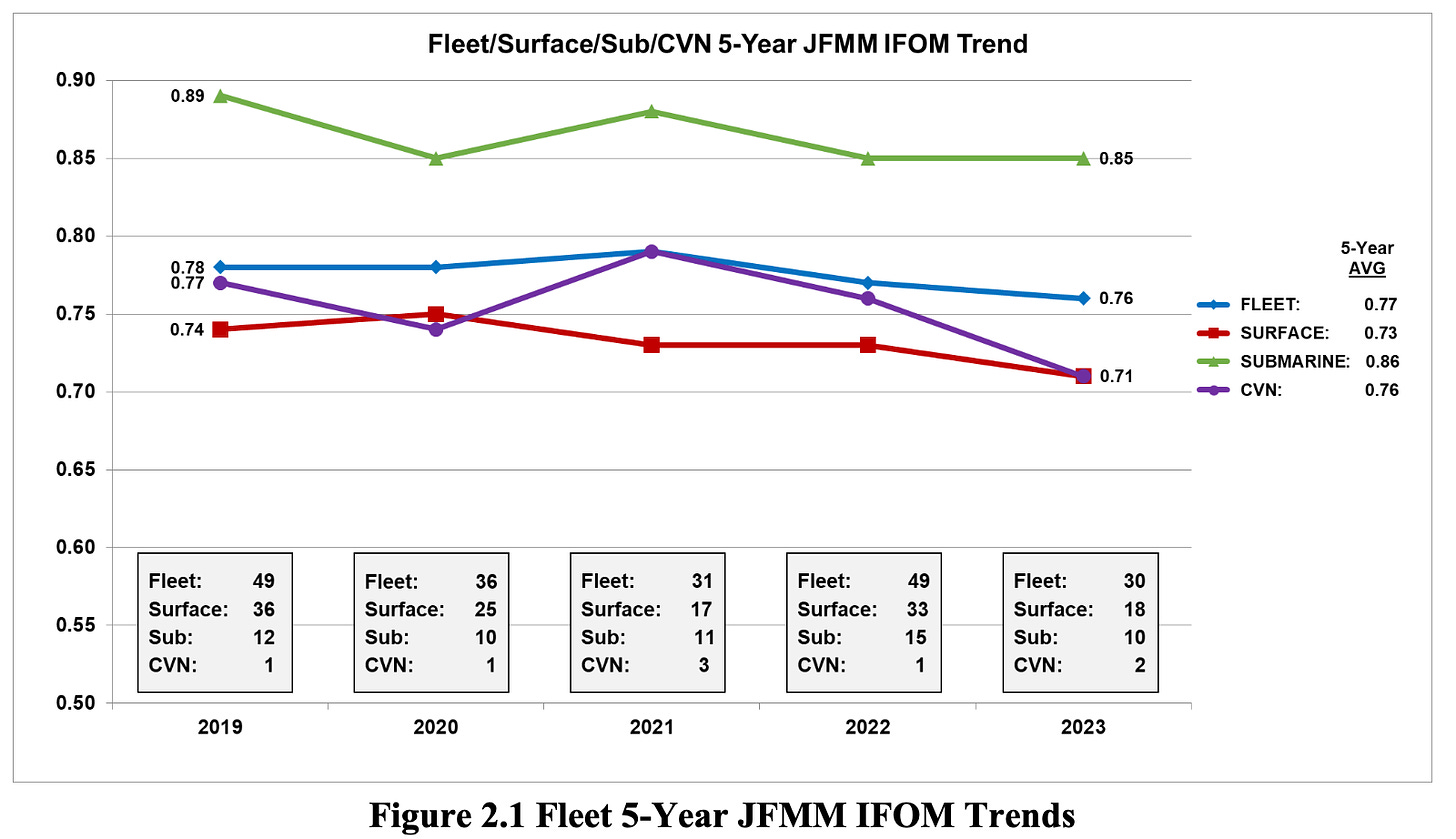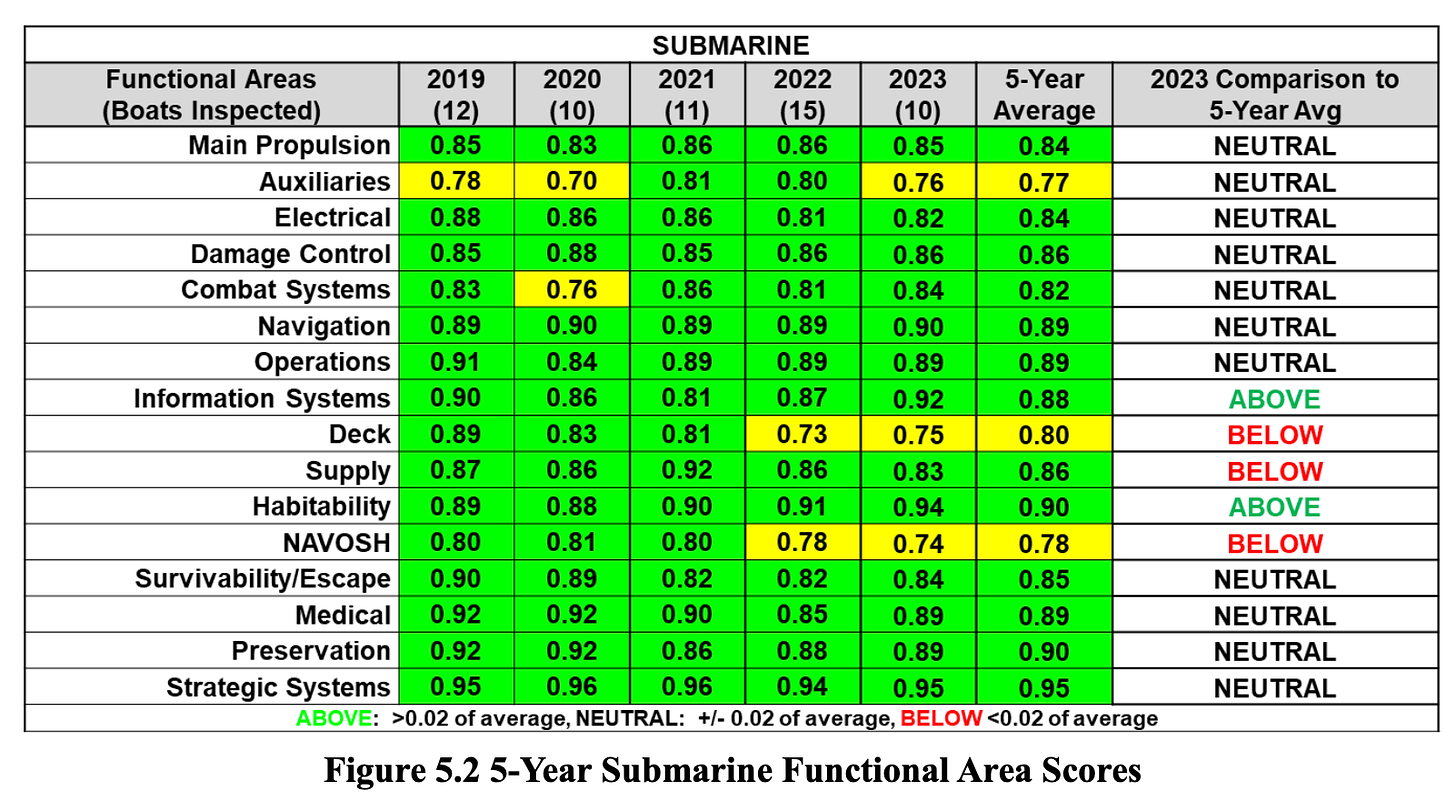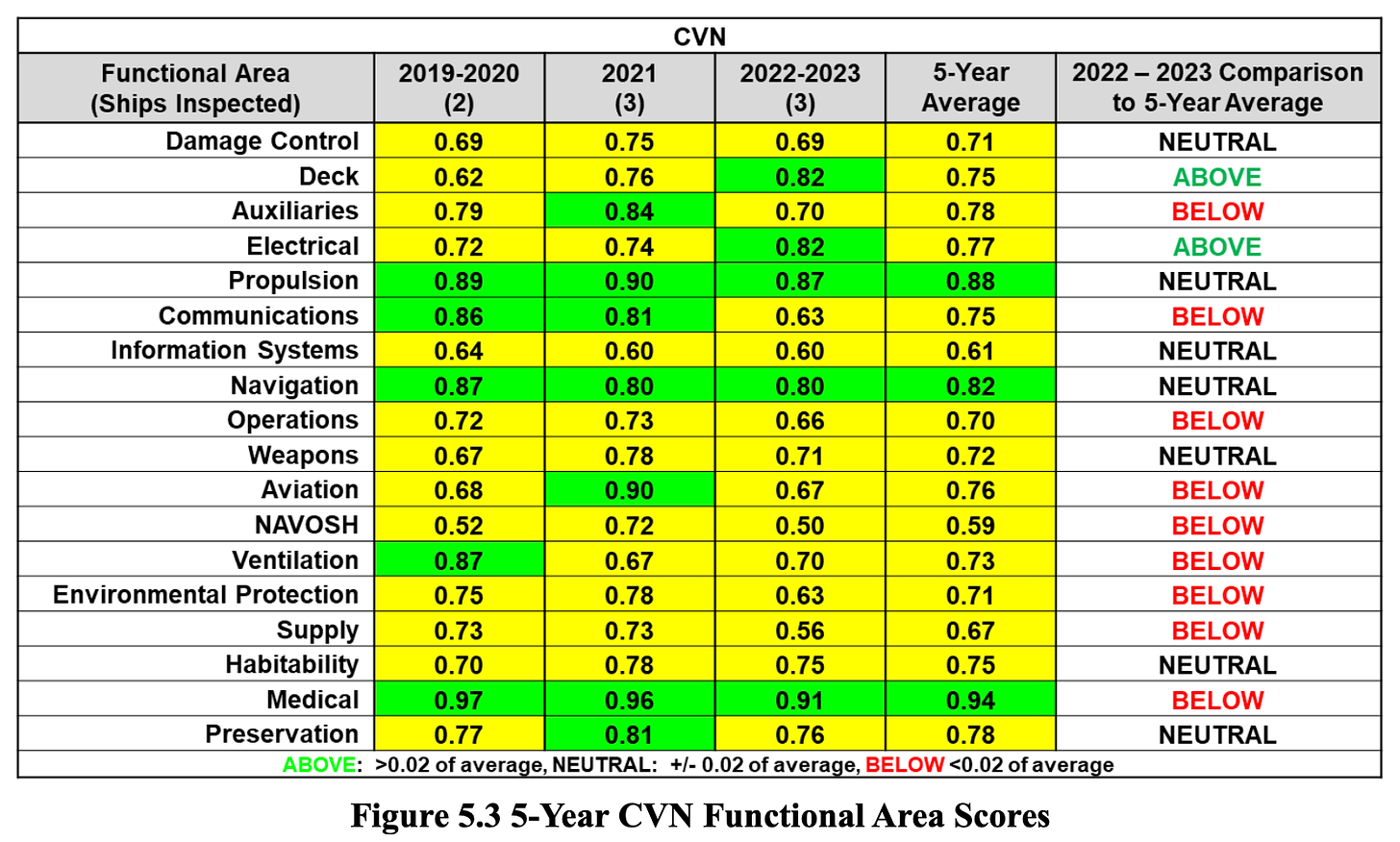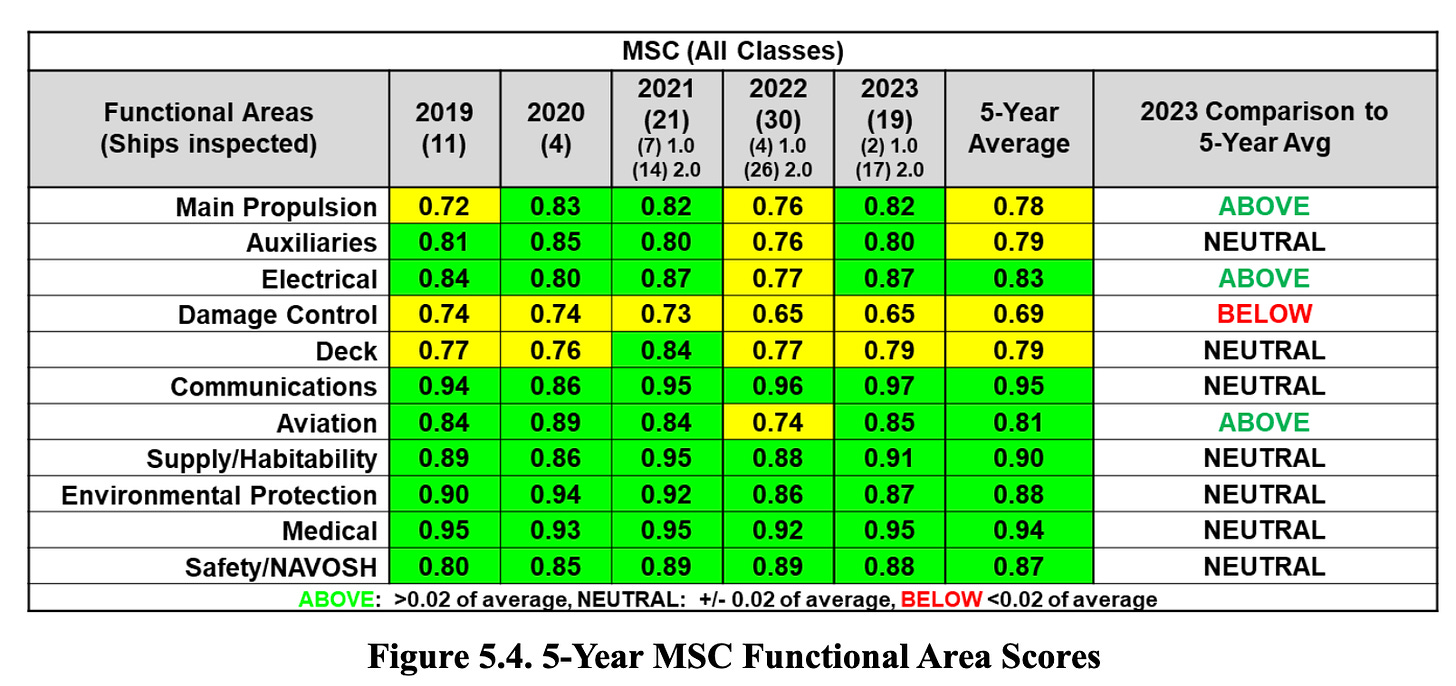My opinion has not changed in the 15 years since our Navy decided to classify INSURV reports. My 2009 comments stand.
Maintenance issues were being hidden then and as a result have only gotten worse. Over classification and hiding of bad news has exactly the effect we said it would. Really is disgraceful, and now has become and even deeper part of our institutional culture.
CharlieB has been at the slow-rolling of the INSURV report like a Pit Bull on … a steak bone.
2023 #INSURV report was finally published a few days ago. It was due 1 MAR 2024 (US Code Title 10 §8674), but shared with the public after ~215 days & well after budget hearings.
I put this delay in the, “Our Navy suffers from the cancer of a culture of untruth” folder. There is no excuse for this…though I’d love to hear it. Anyway, enough of my whining. Back to the substance.
Here’s the context to the graph that hits you in the forehead in the Executive Summary:
The overall combatant Fleet material condition average declined slightly by 0.01 in FY 2023 (seeFigure 2.1). All INSURV Figure of Merit (IFOM) scores and trends in this chart reflect material condition assessment scoring that closely adheres to the Joint Fleet Maintenance Manual (JFMM), Volume VI, Chapter 5, Appendix A Equipment Operation Capability (EOC) metrics of 0.0 (totally inoperative) to 1.0 (fully operable).
BEHOLD!
Remember, those are 2023 numbers. Remember what we have discovered about the submarine maintenance issues this year, and how hard we are running our surface fleet in response to the Red Sea and Iranian challenge, it isn’t helping things.
Nine of 21 functional areas were below the 5-year average for the surface community. Two were above.
Submarines were looking, again surprisingly, better.
Aircraft carriers though? Yikes.
We may have soft-mothballed 17 USNS ships due to lack of civilian mariners, but MSC isn’t doing all that bad.
When you look at the first graphic, you don’t need to see the numbers to see the trendlines. As such, you would think that—especially with there not being enough ships to begin with—we would want to reverse those trends as we get ready for the window of greatest vulnerability for a conflict west of the International Date Line.
You cannot send money and resources to correct problems unless you identify what those problems are. We can agree with that, yes?
INSURV is one of the best ways to do that. Are we acting like it?
INSURV manning derives from inspection periodicity requirements. Prior to FY 2019, inspection periodicity generated a requirement for approximately 60 total inspection events (MIs/Trials/Surveys) per year. INSURV does not possess sufficient funded billets to perform all inspection elements, especially the most specialized, specific technical requirements. INSURV bridged the capacity/capability gap by using Regional Maintenance Center technicians as inspectors, along with inherent scheduling authorities. In FY 2015, the U.S. Fleet Forces Command Manpower Analysis Team (USFF CMAT) validated 56 billets to address the gap using the Shore Manpower Requirements Determination (SMRD) process. 40 of these billets were funded and filled in FY 2019 – FY 2020, the remaining billets are either funded in future years or remain unfunded.
If we have serious leadership focused on a fleet being ready to fight, 56 of these 56 billets would be filled. Can’t find the funding for them? OK, identify for me how many DEI-related billets are in the fleet in those same +/-1 paygrades. I’ll find your 16 billets. All that needs to be done for then is for Millington to recode the billets and shift the MSC to the appropriate UIC.
It is that simple. We do that every day. All we need is for the CNO to say, “Make it happen” and it will…but for some reason we think it is OK for the Navy bureaucracy to work at the speed of smell.
Remember my favorite measure of time? No, not fortnight, the one I coined Back in 2015: worldwar.
A worldwar is the length the USA was involved in WWII; 1,366 days.
So, how many worldwars will this take?
Congressional emphasis on, and the CNO’s commitment to, meeting Title 10 periodicity requirements beginning in FY 2020 generated a requirement for approximately 102 total ship inspection events (MIs/Trials/Surveys) per year. This requirement generated a situation similar to what INSURV experienced leading to the FY 2015 SMRD. USFF CMAT returned to INSURV in early FY 2020 to conduct a Management Analysis Study (MAS, a focused SMRD), to specifically define manning requirements to meet increased periodicity. This study validated an additional 99 billets consisting of 20 Officer requirements, 52 Senior Enlisted requirements, civil service requirements, and 3 specialized engineering requirements aligned to Norfolk Naval Shipyard. In July 2022, INSURV was authorized to hire all 40 unfunded civilian billets. 55 military billets are currently programmed for funding in FY 2025. INSURV expects the remaining billet requirements to take several years to realize. In the interim, INSURV is pursuing a contract vehicle to hire inspectors under the cognizance of INSURV to bridge the capacity gap.
This capacity gap negatively impacts INSURV’s ability to meet a 3-year inspection periodicity.
Under current manning, average inspection periodicity is approximately 4.7 years. This average is expected to remain steady until INSURV is fully manned.
So, 2020 through 2025 is what, 1.5 worldwars or so? At present, we were content to allow INSURV manning to be such that INSURV periodicity is 1,717 days, or 1.25 worldwars.
Don’t forget, the condition of our ships is not an accident. It isn’t from the fact we don’t have lead paint anymore. It isn’t because we don’t have enough billets (we do, just in the wrong places for the wrong reasons). It remains this way because we allow it; we’ve become content with the status quo, and it simply isn’t a priority.
Decline is a choice. Decaying readiness for war is a choice as well.









Senator Tom Cotton commissioned a report and delivered it congress in July of 2021. “A report on the fighting culture of the US Navy Surface Fleet” was stunning in its rather short but succinct conclusions. The surface navy has leadership problems. Go figure. Add this report in with today’s post and one gets the picture of a demoralized poorly lead Navy. As a Marine Infantry Officer (1978-82) I ought to be busting the buttons on my dress blue blouse, but wait, we suck more! Plus our wounds have been self inflicted by two of the worst commandants in the history of the Corps, in fact they are the worst. We are tied at the hip with our brothers and sisters in arms of the naval service, if it is bad for you, it is bad for us. (Besides who the Hell can we tease when gallows humor is the order of the day?) the report which was led by two retired flag officers, one a Marine and the other Navy, was stunning in highlighting just how badly the “Culture” has become, as former SecNav John Lehman opines for the report, “if zero tolerance were in place when I was in the Navy, I wouldn’t have made it past Lieutenant J. G.” That for sure would have been the case for this Marine, counting basketballs in special services would have been lucky, a couple of NJP’s and or worse more likely. But we all flourished in a very different environment. If one couples this micromanagement style (150 flag officers?) with the 10,000 mile screw driver, with the ineptitude and or corruption, it isn’t hard to see that we need more than lead paint to support a robust surface fleet. But beyond that, this culture of mistrust and Diversity, Inclusion and Equity (DIE) will lead to defeat in detail, as the fleet is run to its limits, the Corps stretched on reduced capability due to “divest to invest” and so on and so forth.
At some point it has to stop, the prudent way forward would be to sack a bunch of flag officers for laziness and stupidity, force out some generals in the Corps for being traitors to the Eagle, Globe and Anchor and bring in some young fresh blood. We start start with asking Jim Webb to come back as SecNav for two years…do what you will Secretary Webb, but start with kicking ass and taking names.
Thanks again CDR Salamander for a great post. Now where is my P38, my can of beef and rocks needs opening.
CDR Sal, on target. Unfortunately, depressingly so. As you say, "Decline is a choice. Decaying readiness for war is a choice as well." Agree, but have to ask, WHO chose to decline, and perhaps more (most) importantly why? INSURV provides analysis of the "what" activities requiring accomplishment. "Someone" has chosen to give little credence and / or ignore those findings / recommendation(s). Would note that tendency to "be ignored or belittled" extends to analysis organizations across ALL parts of DoD (intel, manpower, logistics supply, etc ad nauseum). As a result our ability to actually do analysis and identify problems to be "fixed" has declined (that word again) as well. I guess if the "boss" doesn't want to hear bad news, well, we just won't give it to him because if we give him bad news, I'll get fired. Hence the ORSA's lament: "What do you want the data to say, general / admiral / Mr. Secretary?". The old "who, what, when, how and why" questions are always useful. Listen to what they say, watch what they do, and follow the money provide useful information occasionally as well.